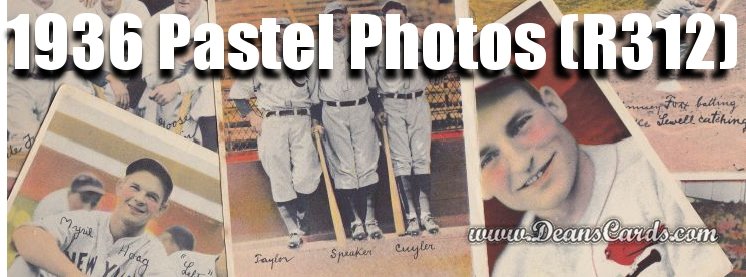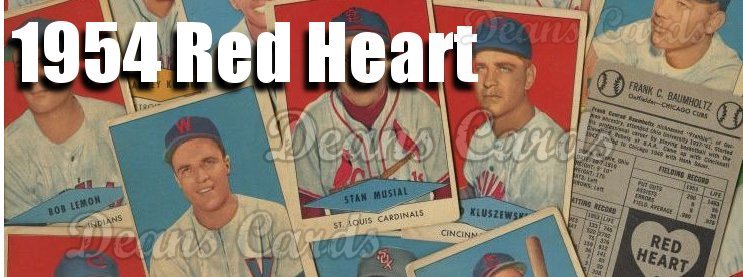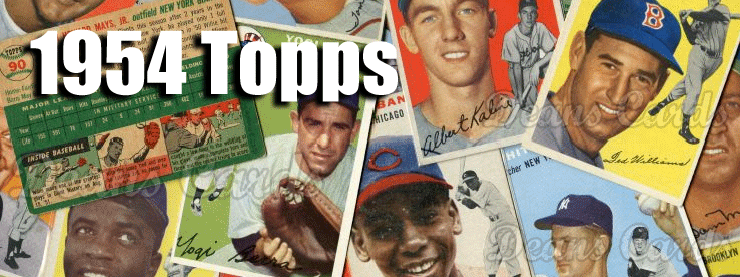This article was written by Dean Hanley and was published in the July 3, 2012 issue of Sports Collectors Digest.
While Bowman was still reeling from its expensive
1953 color venture, Topps was enjoying its newly discovered success in the competitive world of bubble gum baseball cards. Sy Berger refused to lose the initiative and was determined to further improve the Topps product offering.
While Sy Berger had contracted for artists to hand-draw the
1953 cards, he wanted a new and cutting edge design for the 1954 issue. He would borrow from the
1952 set and again use colorized photographs, although this time Berger wanted to include a black-and-white action shot that would lie across part of the colorized portrait. This concept proved to be a tough sell to both Topps executives and artist Woody Gelman, who all initially disliked the concept. Berger, who was never one to be easily discouraged, kept persisting and finally got his way. The result was the most attractive baseball card produced to date.
Years later, Sy Berger recalled, “I had advocated action photography for three or four years. They wouldn’t hear of it, and I had two big file cabinets full of action pictures. They did a survey and found out that the kids wanted action pictures. They came to me in December and said, ‘Where are we going to get color action pictures?’ – and I had them.”
Each of the
1954 Topps cards features a large color image of the player’s upper torso, which shares the remaining space with a smaller full-body black-and-white photo of the player in an action pose. Each card contains a large team logo at the top of the card and a facsimile autograph at the bottom of the card. Located next to the team logo at the top of the card is the player’s name, position, and team name. A bright, colorful background that extended all the way to the card’s top edge sets the design and makes the player’s image appear to jump off the card. The backs of the
1954 Topps cards are just as busy. Printed on the back is personal information, history, statistics and a colorful, eye-catching cartoon about the player.
The 1954 Topps baseball card set includes 250 vintage size cards, each measuring 3⅝” by 3¾”. The year is unique in that it’s a mixture of aging stars from the pre-war era of baseball as well as rookies that would be destined for the Hall-of-Fame. Topps had once again manufactured an exceptional set that would stand out amongst the Gum Cards War chaos of the 1950s.
A Great Rookie Card Class
The 1954 Topps cards captured the new burst of talent that was beginning to transform the game of baseball. In 1954, Topps (or should we say Sy Berger) was insightful enough to secure the rights to print all the rookie cards of three bright and exciting players who would be perennial All-Stars for the next two decades and eventually be enshrined into the Baseball Hall of Fame. These were:
#94 Ernie Banks,
#128 Hank Aaron, and
#201 Al Kaline.
The 1954 Topps set also contains the rookie cards of
#25 Harvey Kuenn – A.L. Rookie of the Year and
#132 Tommy Lasorda – who would be enshrined as a manager. This impressive list of baseball giants would prove to have a great impact on the sport for years to come and Banks, Aaron, Kaline and Kuenn would go on to play in a combined total of 63 All-Star games! The 1954 Topps set also features the exclusive cards of Hall of Famers
Jackie Robinson and
Warren Spahn.
“Teddy Ballgame” comes home from war
Topps and Bowman were still competing for the baseball card market as well as the player rights to produce the cards. By 1954, Bowman was pulling ahead in the number of players it had signed to exclusive contracts. Sy Berger, a Red Sox fan, had been desperate to sign
Ted Williams, who was exclusive with Bowman.
Berger’s coup of 1954 was signing Williams to a five year contract. For the first time, Topps offered a player (Williams) more money than the standard contract in order to get him to appear on a Topps baseball card.


To help justify this cost, Topps featured Williams on both the first and last card in the set (
#1 and
#250). Bowman also printed a card of Williams without realizing that he had signed an exclusive contract with Topps. Bowman was forced to stop production of the
#66 Ted Williams card, thus making it the most scarce and valuable card in the
1954 Bowman set.
Trying to make Chicken Salad without much Chicken
There are 60 cards featuring rookies in the relatively small
1954 Topps Baseball Card Set. Although the set had only 250 cards, Topps once again struggled to fill out the set due to contractual obligations of many of the players. To reach this number of cards, Topps printed cards of 25 coaches and managers. Many of the players and managers featured in the 1954 set would never have another card printed.
Other characteristics
Instead of an expensive high numbered series, the second series of the
1954 Topps set (#51 - 75) is considered more expensive to collect. Despite a lack of stars featured in this series. The first series (#1-50) has been printed as a gray-backed version that may have been released in Canada. Topps also printed its first multi-player card, which featured twin brothers
#139 Ed and John O’Brien.
What frustrates collectors, both in 1954 and today, is that the back of the cards are not oriented in a consistent manner.
The 1954 Topps cards do not have a white border on the top of the card, which adds to the card’s beauty. In order to achieve this “bleed” feature the tops of the cards were lined-up against the tops of the cards of the next row on the printing sheet– so that half of the cards would be upside down on the sheet. This is the same technique that Topps used for its
1953 set. However, in 1954, the printer must have forgotten to orient the card backs in the same manner. Therefore, when the front of the cards are stacked to face the same way, half of the card backs have the card oriented to the left and half have the back oriented to the right. When the
1954 Topps cards are sorted in a box, one-half of the cards have the number at the tops of the card and one-half have it at the bottom. Fortunately, Topps never repeated this mistake.
Summary
The 1954 set would stand out from the previous three Topps sets for several other reasons as well. Unlike the
1952 and
1953 sets, there were no short printed cards, making the
1954 Topps set much easier to collect. For the first time, Topps used dual images on their card fronts. The black and white action shots that were superimposed next to the color head shots demonstrated just how innovative Topps was at the time. These dual images would appear on many Topps cards in the years to come. Although their lack of exclusive player contracts put Topps at a disadvantage when compared to Bowman, Topps certainly made up for it with their brightly-colored
1954 set.
In 1954, there was little doubt that Topps had the most attractive baseball card. Naturally, collectors responded. DeansCards.com sells about five
1954 Topps cards for every three 1954 Bowman cards. I assume that the ratio was about the same with collectors in 1954, as both companies were very cost-conscious and did not want to waste money to print cards that would not sell.1954 was the third consecutive year that Topps outsold Bowman in the baseball card market.
This article is taken from Dean’s book “The Gum Card War and the Great Bowman & Topps Baseball Card Sets of 1948-1955”, which is now available for sale at Amazon.com.
Dean Hanley is an authority on vintage sports cards and has written numerous articles on the topic. Mr. Hanley is the founder DeansCards.com, and with well-over one million vintage cards in inventory, DeansCards.com is the largest seller of vintage cards on the web. Dean has also published “Before there was Bubble Gum: Our Favorite Pre-World War I Baseball Cards”, which is also available in eBook form at Amazon.com and has just released a T207 reprint set. For more information, please visit www.DeansCards.com
If you are looking to sell your cards we would be
happy to hear from you. Please fill out our sell your collection
form here and we
will be in touch.


































